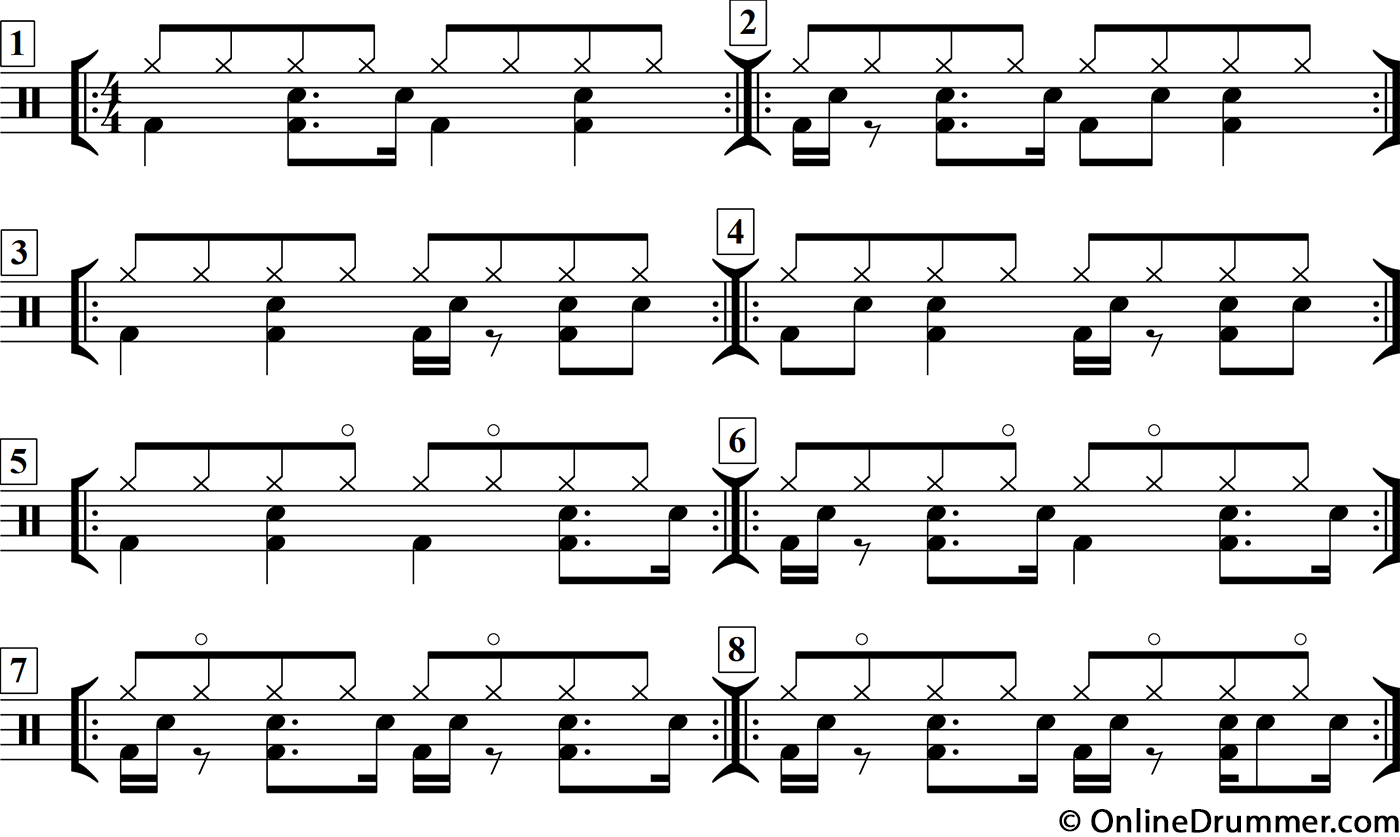
Drumming is like a rhythmic playground, with beats that can transport you across eras and cultures. It's incredible to think that centuries ago, drum patterns were simple rhythms, used in tribal ceremonies or to keep the cadence of marching soldiers. But today they've evolved into something far more intricate.
If you're a drummer on the rise, this list of 10 easy drum beats for beginners is your roadmap to rhythmic prowess. We start off easy, so you can get your feet wet without drowning. The first half of the list is straightforward, offering a gentle entry point. As you progress, they slowly get more demanding, with the final two being the toughest challenge.
Each beat has a difficulty listed on a scale of 1-10, with 1 being entry level and 10 being a more intermediate to pro level pattern. If you can get all of them down, you'll have a rhythmic vocabulary that's rich, diverse, and versatile. So let's get started, by taking a trip back to the decade of disco!
1. Four-on-the-Floor
Genres: Dance, Disco, Rock
Difficulty: 1
The Four-on-the-Floor beat is like the heartbeat of dance music, producing a steady thump that's perfectly synchronized with the bass. It was first introduced in disco and gained major traction in the '70s. Today, this beat is the cornerstone of EDM, techno, and even some pop music. Its timeless nature allows both novices and seasoned drummers to use it effectively.
What sets it apart is its utter simplicity and relentless focus on the downbeat, which makes it both easy for beginners and indispensable for pros. It's straightforward to learn: strike the bass drum on all four counts of a 4/4 measure.
This beat is most popular in Western cultures but is so ubiquitous that you'll find it worldwide. If you're a drummer of any level, mastering this beat provides a foundation for more complex rhythms.

In 1977 "Stayin' Alive" was released by the Bee Gees as part of the "Saturday Night Fever" soundtrack, becoming an anthem of the disco era. The song topped the charts and became synonymous with disco culture, appealing to dance club enthusiasts and mainstream audiences alike. The Four-on-the-Floor beat gives this song its iconic, danceable groove. The consistent bass drum on every beat drives the song forward and is the foundation of its infectious rhythm. Interestingly, this beat isn't just good for dancing; it's often used in CPR training due to its ideal tempo for chest compressions.
2. Straight Eighth
Genres: Rock, Pop
Difficulty: 1
The Straight Eighth groove is like the bread and butter of rock music. It was initially popularized in the '60s and has its roots deeply embedded in rock and country. Unlike Four-on-the-Floor, which emphasizes the bass drum, Straight Eighth adds more complexity with its hi-hats.
To play it, you'll need to hit the hi-hat on each eighth note while maintaining a steady kick-snare pattern. It's not as straightforward as Four-on-the-Floor but still very accessible for beginners.
This beat has a strong presence in modern alternative rock and indie genres. It's particularly versatile and is almost a rite of passage for drummers aiming for that rock sound. Knowing this beat can help drummers in a myriad of settings, from garage bands to large concerts.

"Smells Like Teen Spirit" took over the airwaves in 1991 quickly becoming the soundtrack of a disaffected generation. Its simple but gripping Straight Eighth beat matches the raw emotion conveyed in the song. That beat adds intensity, providing a strong backbone to the iconic grunge sound. Its popularity reached far beyond just grunge fans, capturing a mainstream audience and pushing grunge into the limelight.
3. Two and Four Backbeat
Genres: Rock, Pop, Hip-hop
Difficulty: 2
At the core of Western pop music, this beat emphasizes snare strikes on the second and fourth counts of a measure. New drummers will find it easy to master, but the potential for improvisation also engages pros. Its roots stretch back to the jazz and blues scenes of the '40s and '50s, expanding its influence to today's R&B, soul, and pop genres. To get started, you'll mainly be hitting the snare drum hard on counts 2 and 4 while keeping a steady kick and hi-hat rhythm. Drummers aiming to be versatile should have this rhythm in their toolkit.
If you're a newbie drummer, this is your entry point. To play it, focus on hitting the snare drum on the 2 and 4 counts, while the kick drum goes on the 1 and 3. Your hi-hat should be keeping time, usually with eighth notes. Practice this slowly, then increase the tempo as you get comfortable. This will help you internalize the groove and make it second nature.

"Superstition" is a funk masterpiece released in 1972, and it became one of Stevie Wonder's most famous tracks. Its Two and Four Backbeat is impossible to miss and makes the song incredibly danceable. This beat pattern provides a soulful groove that resonated not only with funk fans but also mainstream audiences.
4. 8th Note Groove
Genres: Rock, Pop
Difficulty: 2
The 8th Note Groove is ubiquitous in popular music and adds fullness to the rhythm, providing a consistent backbeat that's peppered with hi-hat hits on every eighth note. It initially made its mark in the blues and jazz scenes and is most often found today in rock and pop genres. If you're new to drumming, this beat is your friend; it's one of the first beats many drummers learn.

The beauty of the 8th Note Groove is that it serves as a blank canvas for both beginner and experienced drummers. The straightforward pattern requires hitting the hi-hat on every eighth note, while the snare and kick fall on the standard 2 and 4, and 1 and 3 counts respectively. It’s the go-to beat if you’re aiming for a fuller sound that doesn’t feel overcomplicated.
Released in 1982 for the "Rocky III" movie soundtrack, "Eye of the Tiger" rapidly climbed to the top of the charts. Its 8th Note Groove adds a sense of urgency and resolve that mirrors the song's message of determination. A hit across a variety of audiences, it became an enduring anthem for sports events.
5. Shuffle
Genres: Blues, Jazz, Rock
Difficulty: 3
Enter the world of blues and jazz, and you'll encounter the Shuffle beat. What sets the Shuffle apart is its unique 'swing' feel, which is drastically different from the straightforward 8th Note Groove. Its rhythmic nuances were popularized in the '50s and are still the backbone of blues music. If you’re an aspiring drummer looking to delve into blues or jazz, this beat is a must-learn.
While it's not the easiest beat for beginners, the payoff is worth the initial struggle. The secret sauce in the Shuffle lies in the hi-hats: the notes swing, rather than hitting at regular intervals. The snare typically falls on the 2 and 4 counts, while the kick punctuates the 1 and 3. It's an essential beat that brings a unique swing feel to a drummer’s toolkit.

Blues aficionados and mainstream listeners alike couldn't get enough of "Pride and Joy" after its 1983 release. The song's shuffle beat gives it its rollicking, toe-tapping quality, capturing the essence of blues and rock. This rhythmic pattern is central to the song's feel and has influenced countless blues guitarists and drummers.
6. Train Beat
Genres: Country, Bluegrass
Difficulty: 4
If you've ever listened to classic country or bluegrass, you've heard the Train Beat. This beat, which gained traction in the '50s, aims to mimic the rhythmic patterns of a moving train. Although it’s a staple in Southern American culture, its influence stretches far and wide in the country and bluegrass scenes.
It’s not the most beginner-friendly beat out there, but it’s a must for drummers interested in genres that require a fast-paced, chugging rhythm. To nail the Train Beat, it's all about mastering the fast alternation between the snare and the hi-hat, which generates that signature ‘train-like’ rhythm. It's a phenomenal skillset to add if you're looking to break into country music drumming.

Known for its unmistakable Train Beat, "Folsom Prison Blues" brought Johnny Cash into the spotlight in 1956. This beat serves as the driving force of the song, mimicking the sound of a moving train and adding to its storytelling allure. It captured the hearts of country fans and introduced a wider audience to Johnny Cash's unique style.
7. 16th Note Backbeat
Genres: Hip-hop, R&B
Difficulty: 4
A staple in funk and R&B, the 16th Note Backbeat injects intricate detail into the rhythm. Drummers are quick to notice its difference from the traditional 8th Note Groove; the hi-hat here is struck at a rapid-fire 16th note pace. Introduced during the golden age of funk in the '60s and '70s, this beat has a deeply rhythmic, groove-centered appeal.
While this beat is commonly found in modern funk, R&B, and hip-hop, mastering it is beneficial for drummers interested in more intricate patterns. The core of the 16th Note Backbeat involves hitting the hi-hat at double the rate compared to the 8th Note Groove. Although it takes some practice, this beat can be utilized effectively by drummers who have moved past beginner level.
The 16th Note Backbeat in King of Pop's massive hit "Billie Jean" provides a captivating rhythm for the song, making it one of Michael Jackson's most celebrated songs after its 1982 release. Appealing to pop, R&B, and dance fans, the beat adds a layer of complexity to its universally danceable groove.
8. Bossa Nova
Genres: Latin Jazz, Brazilian music
Difficulty: 5
Hopefully you're comfortable with the first 7 beats on this list, because our next one requires a bit more coordination that can be a bit of a challenge for beginners. The Bossa Nova beat originated in the late '50s. It has a Latin feel that's the epitome of Brazilian jazz.
To master it, the rhythm should be held mostly in the snare and kick, with a cross-stick pattern on the snare and a syncopated kick. This beat is not just reserved for traditional Brazilian music; it's also used in modern jazz and pop music. Learning it offers a unique rhythmic flair that's a great addition to any drummer's skill set.
"Mas Que Nada" is a Brazilian song originally written by Jorge Ben Jor, but the 2006 rendition by Sérgio Mendes featuring The Black Eyed Peas gives it a modern twist. The track showcases the Bossa Nova drum pattern clearly, making it an excellent example for those interested in this rhythm. The song was a hit upon its release, bridging traditional Brazilian music with contemporary pop and hip-hop, thus reaching a diverse audience. The drumming, with its Bossa Nova elements, plays a crucial role in blending these genres seamlessly.
9. Paradiddle Groove
Genres: Rock, Jazz
Difficulty: 6
Probably my personal favorite on the list, the Paradiddle Groove transforms the basic paradiddle rudiment into a functional drum groove. It's an excellent beat for drummers wanting to improve their hand technique while still keeping a groove. It tends to appeal more to drummers interested in rock and alternative music.
Playing the Paradiddle Groove involves a sticking pattern of RLRR-LRLL across the kit, most often distributed between the hi-hat and snare. We've ramped up the difficulty for the last three beats, so this one may be a bit of a challenge for new drummers. If you want something to challenge your coordination, this groove is the answer.
Paul Simon's 1975 hit, "50 Ways to Leave Your Lover" features a unique Paradiddle Groove. The beat complements the song's storytelling elements and was groundbreaking at the time of its release. This intricate rhythm pattern appealed not only to fans of folk-rock but also drummers looking for creative inspiration.
10. Double Stroke Roll Groove
Genres: Double Stroke Roll Groove
Difficulty: 7
Stepping away from traditional backbeats, the Double Stroke Roll Groove is grounded in rudimentary drumming. This beat is notably different because it heavily relies on a RR-LL sticking, making it a go-to beat for drummers aiming to master double strokes.
The Double Stroke Roll is normally found in experimental genres or technical drumming disciplines. We saved it for the end because it’s not beginner-friendly. We wanted to leave you with a bit of a challenge. The key to mastering it is in the double strokes on each hand, generally divided between the snare and hi-hat. It may take some work, but if you can get it down it's immensely useful for drummers looking to step up a more advanced technique.
The Double Stroke Roll Groove is used in "Take Five" to create its compelling, jazzy feel. Released in 1959, the song transcended typical jazz circles, becoming popular among mainstream audiences and making odd time signatures more accessible.
Drums are a universal language
... a language that has been spoken for thousands of years. The complex rhythms and beats we recognize today on our Apple Music and Spotify playlists can be traced back to tribal ceremonies, war drums, and communal celebrations. While these easy drum beats for beginners might seem distinct, they evolved from those earlier, simpler patterns, becoming something far more complex as drummers push the limits of creativity and skill. Organic drumming remains an invaluable skill despite the new digital, AI-generated music landscape. By learning these 10 easy drum beats for beginners, you can add a level of human touch, dynamic range, and emotion that a machine can't replicate. You're not just keeping time and learning to rock, you're continuing an organic tradition that's as old as humanity itself.







Leave a Reply!
Thank you so much for putting solid content you put out each week! It's not always applicable to me, but I love reading it, as you've clearly done research for useful topics.